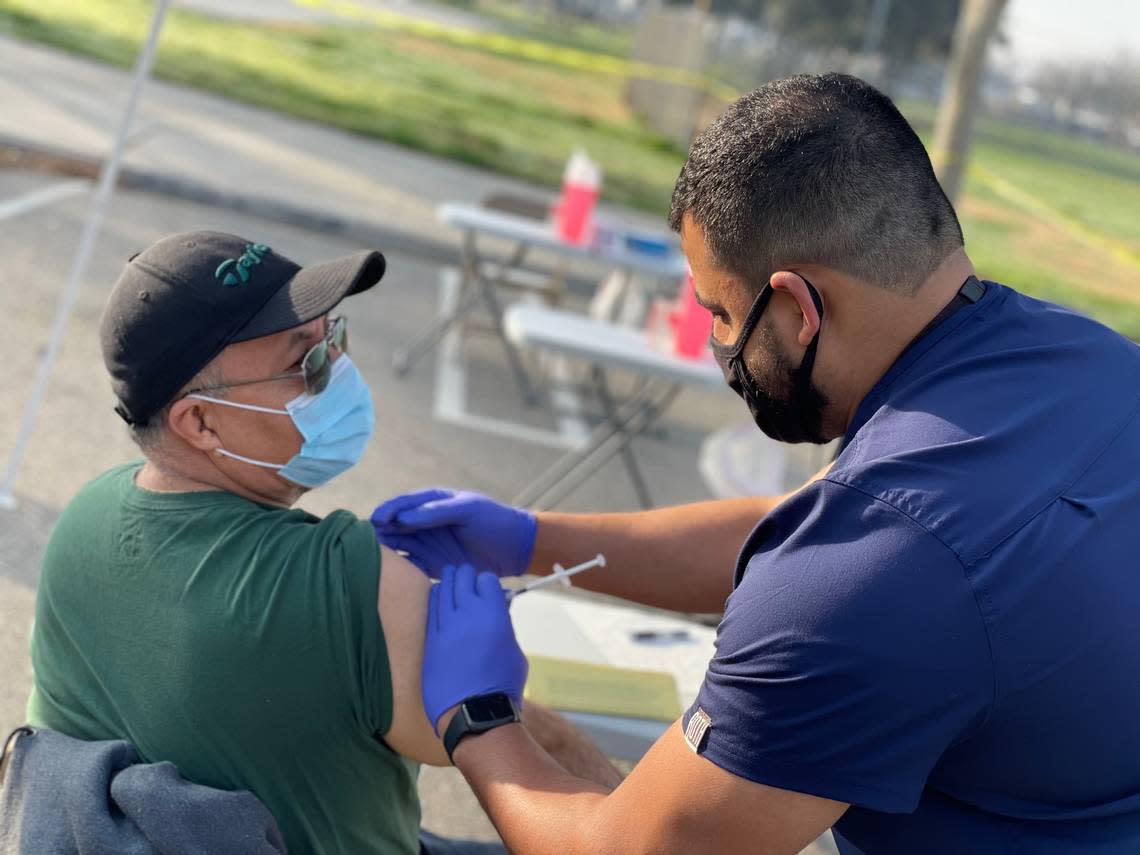Can vaccine booster shots suppress the next COVID-19 surge in Stanislaus County?

- Oops!Something went wrong.Please try again later.
State and local health officials are favoring booster shots as one of the tools for avoiding or minimizing another surge of COVID-19 disease this winter.
Dr. Tomas Aragon, the state’s public health officer, said Tuesday that some COVID patients in hospitals are elderly people who were previously vaccinated against the coronavirus.
The state is expecting a rise in breakthrough cases unless people roll up their sleeves for a booster dose of COVID vaccine. The majority of people being hospitalized for COVID-19 are unvaccinated, Aragon said. The state is trying to get more shots into arms and also is promoting flu vaccinations to keep the pressure off hospitals in the next two months.
Aragon, director of the state Department of Public Health, said almost 90% of Californians age 12 and older have received at least one vaccine dose. When so many are vaccinated, some will end up in the hospital with a breakthrough illness, he said.
Older age and underlying medical conditions usually are factors for those patients. Also, the immunity derived from the vaccine decreases over time, and no vaccine is 100% effective, Aragon pointed out.
The national Centers for Disease Control and Prevention last week opened the door for any adults to receive a booster dose if more than six months have passed since completing the original two doses of Pfizer or Moderna or more than two months have passed since the initial Johnson & Johnson shot.
Aragon said in a telephone interview that immunity is not as strong for adults over 50. He is among health experts who believe the Johnson & Johnson vaccine should have been two doses to begin with. “Everyone who got the (J&J) vaccine should absolutely get a booster,” Aragon said.
The state’s top health officer said COVID-19 transmission will increase as people gather indoors for holiday festivities. But it is more difficult to predict the impact on hospitals in the San Joaquin Valley, where about 58% of the population is vaccinated against the respiratory disease.
In addition, the region suffered from high rates of transmission in the previous coronavirus surges and those who were infected have some level of immunity, though a vaccination is still recommended for them, according to the CDC.
Whether it’s a continued struggle with COVID-19, as in Fresno, or patients admitted for other medical conditions, hospitals in the Valley are stressed, Aragon said.
Even if there is a moderate number of COVID-19 cases in late November and December, an increase in seasonal influenza will challenge the Valley’s hospital system. Several hospitals are bringing in staff and additional resources.
There are 67 surge beds in the San Joaquin Valley region, as well as additional skilled nursing beds, Aragon noted.
In September, the delta strain of COVID-19 pushed hospitals to the brink from Stockton to Bakersfield, triggering surge protocols due to hospitals running out of intensive care beds. The protocols allow impacted hospitals to transfer patients to other counties that have available space.
As the upcoming holidays bring families together in homes, public health experts worry that people who still are not vaccinated will contract the virus and could become seriously ill or die.
Aragon advised residents who come down with COVID symptoms and test positive to take advantage of treatments, such as asking their physician if monoclonal antibodies are right for them.
County makes booster shots available
Kamlesh Kaur, a health educator for Stanislaus County, said the immunity from the Pfizer and Moderna vaccines weakens after six months. The delta and other coronavirus variants are more resistant to the vaccines.
A study published in the journal Science, which looked at vaccines given in the Veterans Health Administration, concluded that effectiveness against infection dropped from 88% to 48% from February to October, though effectiveness against death remained above 80% during the delta surge between July and October.
Kaur said people 65 and older and adults with underlying health conditions are especially recommended for a booster dose because of the risk of breakthrough infections.
Booster doses of COVID vaccine are offered locally at county-hosted vaccine clinics held every week. Kaur said all three vaccines are available at the clinics.
She said adults wanting a booster can walk up to a county vaccine clinic, but scheduling an appointment through the state MyTurn program is recommended.
People walking up to clinics have to register before getting the shot. The registration process takes about 20 minutes, Kaur said. Those who get an appointment through MyTurn don’t have to wait in line, she added.
Health care providers, community clinics and pharmacies are also providing COVID-19 booster shots.
Sutter Health on Monday began scheduling booster doses of Pfizer and Moderna vaccine for patients 18 and older.
New cases of COVID-19 are falling in Stanislaus County as the state discusses a possible wave of infections around the holidays. On Tuesday, the county’s case rate was 14.5 per 100,000, down from 24.8 per 100,000 two weeks ago. There were 85 COVID-positive patients in the five local hospitals.
Stanislaus County is placing a new focus on COVID-19 prevention in older populations. Kaur said local hospitals have been admitting COVID-positive seniors who have never been vaccinated before.
County public health is stepping up vaccine messaging for the older age groups. Flyers are being sent through the Area Agency on Aging, and the county is partnering with community organizations to provide vaccine information to older residents.
Information on vaccines also will be sent in city of Modesto mailers to utility customers, Kaur said.
The Stanislaus County Health Services Agency has information on COVID vaccine clinics at www.schsa.org.

